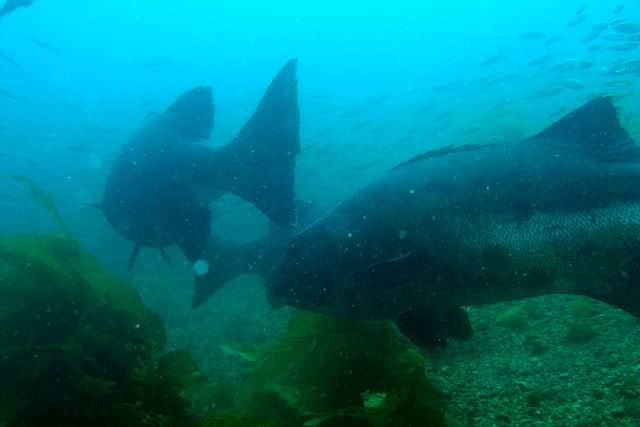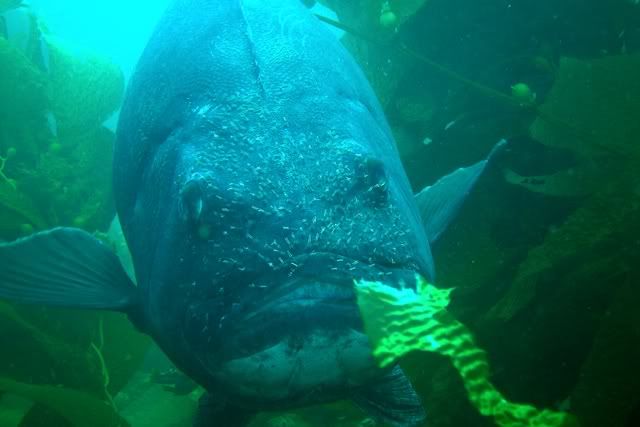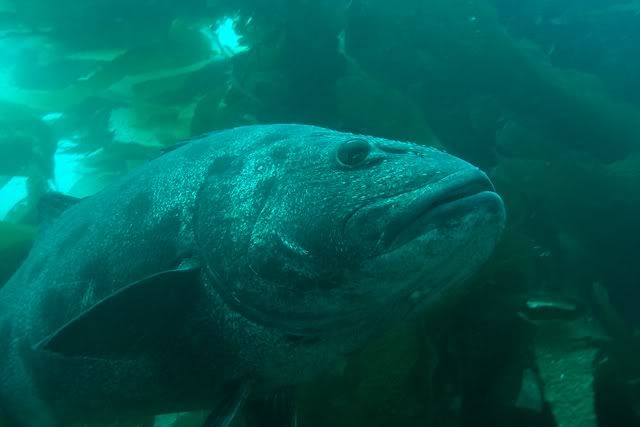With my Cephalopods of SoCal "in the can" it was time to return to diving on the King Neptune. And a great weekend of diving it was. In fact, I did 10 dives over the three days... more than I did all last month!
Best dives were with the giant sea bass (four dives in all this weekend). I saw at least 12 on one dive and possibly 13 on another. Initially they seemed a bit skittish on the first day, but once they realized Dr. Bill was only going to film them, not eat them, they started posing for me.
My impression of the bass this year is that initially they've been skittish, at least in the early season. The males did get into their usual chases, but didn't seem to be "herding" the females as much as in past seasons. It could be temperature related. Of course the ladies would pose for me, and I was happy to have a constant stream of males (and a few females) swimming in midwater to get good open water footage of.
Regarding the giant sea bass, I'd like to express a concern.
In the past we've seen mating aggregations, at what were probably historical sites, move after being "harassed" by divers. One such aggregation was at Lover's cove until about 5 years ago. That aggregation was affected mainly by snorkelers and possibly the tour boats since SCUBA is not allowed there, and moved further south.
Now it appears the group at Italian Gardens has finally moved on to a new site. Unfortunately a number of dive boats know about the new location and over the weekend I saw fairly constant diver presence there. Fishers have also been present there with greater frequency than I remember in the past, and I noted several sea bass with fish hooks in their mouths and leaders trailing, "ripped lips" due to fighting a hook, and damage to their operculums (gill covers) which may have been due to heavy monofilament... or a gill disease they get.
Obviously it would be inappropriate to ask dive boats not to go there. However, I think we all need to be aware that we may be impacting the bass at a critical point in their life... reproduction. If we continually disrupt them at their courting and mating sites, we may interfere with this process. It is believed that older fish teach the youngsters where these sites are. If the fish have to keep moving on, the newly matured youngsters may get confused about where they are supposed to mate!
Of course it could be that the bass naturally change courtship sites on a regular basis. We really don't know enough about the process. Of course I, too, am trying to learn from them!
So the advice I would give when divers encounter them at these sites, is that they exercise great control over their desire to get too close. The bass can be approached within feet if done in a slow, non-threatening way. However, you may also see the hovering individuals begin to get "nervous" (to be anthropomorphic) and start to move on. Rapid hand movements and even the light from a strobe can frighten them off. And please don't succumb to the desire to "pet" them.
I have dived Catalina waters since the 60's when the bass were largely gone (at least I didn't see them back then... and I had decent eyesight as a younger man). It is such a pleasure to be able to spend time with not just one or two, but an entire courting and mating group. I've had individual encounters with the sea bass last as long as 50+ minutes even while filming them most of that time.
Just my two cents worth... which of course isn't worth much given the value of the US dollar.
Dr. Bill
PS For those not familiar with these gentle giants, they are the Goliath grouper or Napoleon wrasse of our waters. Historically they have reached weights of up to 800 pounds (the largest ones we see today appear to be about 600 lbs) and lengths exceeding 7 1/2 feet.
You can find out more about them in my newspaper columns 004, 154 and 246.
If you are a real glutton for punishment, you can buy my Gentle Giants DVD about these magnificent fish! Lots of mating (well, at least courtship) and very little munching!
Best dives were with the giant sea bass (four dives in all this weekend). I saw at least 12 on one dive and possibly 13 on another. Initially they seemed a bit skittish on the first day, but once they realized Dr. Bill was only going to film them, not eat them, they started posing for me.
My impression of the bass this year is that initially they've been skittish, at least in the early season. The males did get into their usual chases, but didn't seem to be "herding" the females as much as in past seasons. It could be temperature related. Of course the ladies would pose for me, and I was happy to have a constant stream of males (and a few females) swimming in midwater to get good open water footage of.
Regarding the giant sea bass, I'd like to express a concern.
In the past we've seen mating aggregations, at what were probably historical sites, move after being "harassed" by divers. One such aggregation was at Lover's cove until about 5 years ago. That aggregation was affected mainly by snorkelers and possibly the tour boats since SCUBA is not allowed there, and moved further south.
Now it appears the group at Italian Gardens has finally moved on to a new site. Unfortunately a number of dive boats know about the new location and over the weekend I saw fairly constant diver presence there. Fishers have also been present there with greater frequency than I remember in the past, and I noted several sea bass with fish hooks in their mouths and leaders trailing, "ripped lips" due to fighting a hook, and damage to their operculums (gill covers) which may have been due to heavy monofilament... or a gill disease they get.
Obviously it would be inappropriate to ask dive boats not to go there. However, I think we all need to be aware that we may be impacting the bass at a critical point in their life... reproduction. If we continually disrupt them at their courting and mating sites, we may interfere with this process. It is believed that older fish teach the youngsters where these sites are. If the fish have to keep moving on, the newly matured youngsters may get confused about where they are supposed to mate!
Of course it could be that the bass naturally change courtship sites on a regular basis. We really don't know enough about the process. Of course I, too, am trying to learn from them!
So the advice I would give when divers encounter them at these sites, is that they exercise great control over their desire to get too close. The bass can be approached within feet if done in a slow, non-threatening way. However, you may also see the hovering individuals begin to get "nervous" (to be anthropomorphic) and start to move on. Rapid hand movements and even the light from a strobe can frighten them off. And please don't succumb to the desire to "pet" them.
I have dived Catalina waters since the 60's when the bass were largely gone (at least I didn't see them back then... and I had decent eyesight as a younger man). It is such a pleasure to be able to spend time with not just one or two, but an entire courting and mating group. I've had individual encounters with the sea bass last as long as 50+ minutes even while filming them most of that time.
Just my two cents worth... which of course isn't worth much given the value of the US dollar.
Dr. Bill
PS For those not familiar with these gentle giants, they are the Goliath grouper or Napoleon wrasse of our waters. Historically they have reached weights of up to 800 pounds (the largest ones we see today appear to be about 600 lbs) and lengths exceeding 7 1/2 feet.
You can find out more about them in my newspaper columns 004, 154 and 246.
If you are a real glutton for punishment, you can buy my Gentle Giants DVD about these magnificent fish! Lots of mating (well, at least courtship) and very little munching!
Last edited:







